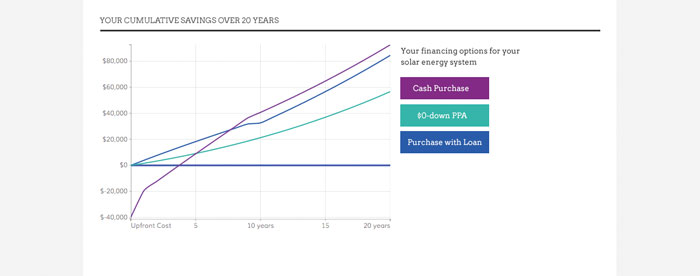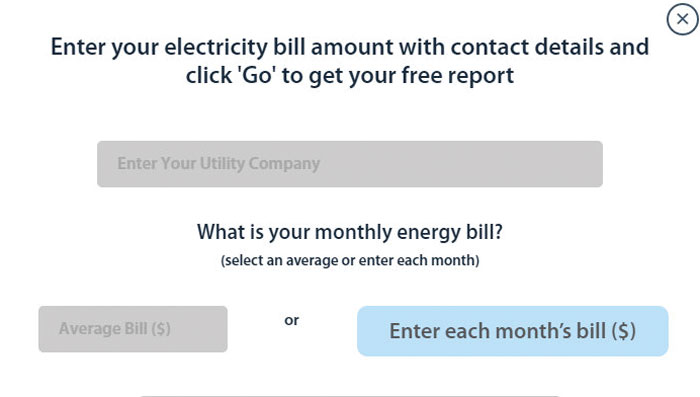Four steps for converting more solar sales
Step 3: Improve Your Efficiency.

Financing can get confusing, but presenting data as EnergySage does here, makes things easier.
Customers have what Aggarwal calls a moment of receptivity. This is that slice of time when they are most likely and interested in doing a deal. Responding quickly and with the right information in that moment greatly increases your chances of getting a deal done.
“The quicker you get them the quote, the more responsive you can be and close the sale,” he says.
According to Conlan O’Leary, co-founder of Sighten Inc., installers are running into efficiency issues related to the explosion of financing options.
“There is more choice and different products for different homeowners, which enables installers to close more customers, but it’s a logistical challenge,” he says. “Installers need to figure out how to offer 10 different financing products from 10 companies who all have slightly different software and different ways of doing things.”
Sighten is a third-party software platform that bridges the gap between financiers and installers. Essentially, it is a sales tool for installers, in which installers can generate custom proposals and deliver actual quotes from interested lenders and investors that have integrated their financial products with the system. The tool comes in a basic model for installers doing as few as five deals a month, to a more robust, customized system for installers doing thousands a month.
RELATED: EnergySage Report: Solar costs falling, installers not brand loyal, and more
The Sighten platform houses the credit criteria, pricing logic and operational and documentation requirements for all of the financial products available in its marketplace, which removes a lot of legwork and questions from the process. Installers no longer need five different systems to look at five different options. There may even be options you didn’t know about. Proposals can also be made on the fly if the financial provider you prefer isn’t in the system.
“We see point solution fatigue in the market,” O’Leary says. “There’s been a lot of innovation to bring disparate solutions together, and here is a holistic solution to run your business on. People sell much more effectively when you do that.”
Step 4: Use Data to Avoid Bottlenecks & Bad Deals.

The utility bill is a pain point and halts deals, so SolyMoly asked Jill and Randy for it upfront.
An ancillary benefit to a system like Sighten is using the data it generates to improve your sales process. You can see that getting an actual utility bill from the homeowner is a real bottleneck and increases install time by seven days on average. Knowing this helps you adjust and move the utility bill to the start of the process to avoid that delay.
“Those next level analytics are sometimes as important as the pure blocking and tackling and generating proposals and contracts every day,” O’Leary says.
Another pain point is putting a proposal together, making a sale and then finding out after the contract signing that the deal won’t support the PV modules you signed off on. Good bye sale and the last week of your life. With the right integrated software, these red flags will pop up earlier or be avoided altogether.
“Financing products will have underwritten criteria, ranging from a FICO score cut off all the way to productivity — kWh per kW rules by market — to ensure they aren’t getting an underproducing system,” O’Leary says. “We can implement all of that. From the moment they enter the address, we are telling them in real time ‘hey, there are 10 products available, but you now have seven in Arizona because three don’t fund systems there.’”
Or turn that data into a filter that can sift through a pile of deals in a snap, prioritizing the best ones. For example, SolyMoly’s multi-channel service enables customers to improve on conversions by eliminating noise and filtering leads based on the following criteria:
• Tree coverage (roof shade)
• Credit-worthiness
• Single family residential homes
• Free standing
• Roof area
• Interest level
“Installers are dealing with 50 percent leads that are not suitable for solar,” Kuppan, says. His goal is for SolyMoly is to save installers time and money by focusing on leads that have a high chance of conversion rather than chasing bad deals. “Installers have a chance of improving their operation efficiency and deal conversion ratios by 30 to 40 percent.”
The EnergySage dashboard, as another example, provides insight into how responsive an installer is to a lead, how quickly questions were answered, how submitted quotes compared to best practices or the best performing installers and more.
So, to sum up: “Sell more, faster and more effectively and then do that incremental volume in a more efficient manner and thereby reduce your attrition rate,” O’Leary says. “It is challenging. Selling is only part of the process. If you sell someone, and then don’t talk to them for three weeks, and then schedule an install six weeks later, you will have a high attrition. You need to continue to engage with customers, and continuing through the project management phase is key.”




